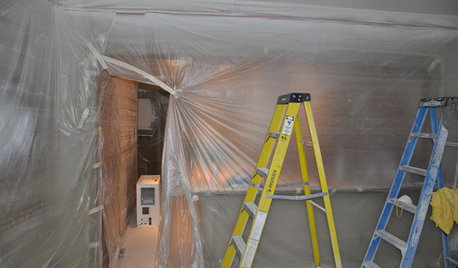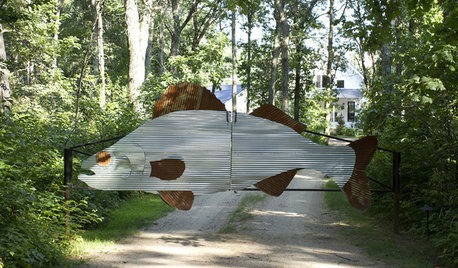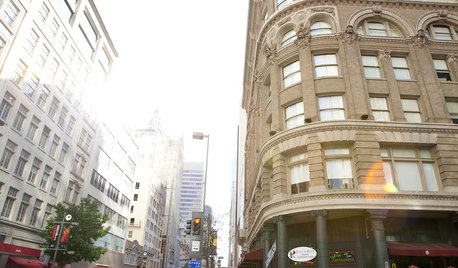Saw '9/11 The Falling Man.' (where do your ethics lie on this?)
amicus
2 years ago
last modified: 2 years ago
Featured Answer
Comments (36)
Related Discussions
Our own little 9-11
Comments (9)Today, it is snowing and snowing. My husband went to work and had to attend meetings, etc, to get past the National Guard posted at the corner. I feel sorry for anyone posted outside in this weather. The firefighters who were up all night were taking naps on the fire truck right outside. The gas pipes turned out to be from 1925, and have very few shut off valves, except where the side lines connect to buildings. They are made of steel and 8 inches wide. I'll bet this system occurs all over America, part of New Deal economic stimulus. Everything's got it's vanishing point and 84 years is a long time. It just keeps snowing, I stayed home and started cleaning house. I need to pick three more roses for my rose garden. I was thinking of trying a couple David Austins, Eglantyne or a Shropshire Lad. But I wouldn't do it if I ended up having to chop the canes down every year and start over. I want some nice tall roses. It seems like, for cold hardy roses, "think pink", but there's too much pink in there already....See MoreCentral Ohio Fall Plant Swap/Potluck-Saturday, 9/20/2008
Comments (42)Hi Everyone, Sorry I didn't make it to the swap today.With everything that's been happening and going on with the weather,I totally forgot today is the day.I really was looking forward to seeing you all.We're really trying to clean up everythng and waiting for help getting things back on the house.We have lots of missing shingles to get back on and the back down spout is laying in the back yard still yet,Not to mention pieces of siding blown off are in the far back yard.And of course a very large tree limb thats too heavy for either of us to move plus all the broken tree limbs and trash that comes along with the ride.But we'll get it done.We were without electric and water from Sunday to Wed.I'm very thankful it wasn't any longer then that and no one was hurt.I'm sorry to hear some of you are still in the dark,But know it won't be long now.I'm very grateful to all the workers who gave up time being with their families and loved ones to bring our power back on. I had so many plants to bring today,But like I said"Totally slipped my mind". I guess I will save them for the Spring Swap.I hope to see you all then.I will miss you all so very much!!Hope you had a good one!! I know you did!! I'll be reading when I can get on line to see what you all swapped for and had to eat. Granny57x...See MoreWW's Support Monday9/11~~Sunday9/17
Comments (12)Hello all. Life keeps getting in the way but I'm still here. Here's a cut and paste from another forum for starters. This was 2 nights ago. Well my day has started with a bang and I haven't been to bed yet. Around 2:30 am the dogs went crazy in the neighborhood. Our Rottie went absolutely nuts and I couldn't see what was going on so I called her back in. Our Lab who has a touch of Coonhound went out and joined in but not like the Rottie. Shasta (the Rot) became extremely stressed when I tried to keep her in so after distracting her with play for a bit I let her go out in the backyard again around 4:30. Both dogs started going at the rear side fence and then I heard a splash, a crash and a lot of hissing, high pitched barking. Got DH up and we saw the dogs had crashed through the fence and they and a large racoon were all in the neighbors in ground pool. DH goes around to the neighbors yard and I stay on our side. He's in the neighbors yard trying to corral 2 large dogs who are jumping in and out of the pool trying to get at the coon swimming in circles and the neighbors are nowhere to be seen. Finally the neighbors turn on an upstairs light and call out their bedroom window to ask what is going on and DH tells them they have a coon in their pool. They don't say anything and turn out the light. DH finally get both dogs back thru the fence. We get them in the house. He gets hammer and nails and repairs the fence. It is still dark and still no sign of neighbors in spite of all the commotion going on in their yard. So now I'm sitting here waiting for 2 wet dogs to dry and the Rotti is strutting around so proud of herself for taking care of the" intruder" and our Lab/Coonhound acts like he just had a fantastic playdate at a pool party. See life in the suburbs isn't always all that dull either. DH had our anniversary dinner on Tues. Tonite I have a Red Hat dinner and on Sat. I have a Red Hat picnic. FOOD and more FOOD. I'm not losing but I'm not gaining either. This is good ;) but I really need to get back on the program and go for he next ten pounds. Jen, WW is great because unless you do their CORE program there are no bad foods. Lots of peeps have great success with the Points System. I don't so I do an old style food exchange plan from the 80's. Great going Trekaren. Welcome Jen and Mooner. Waving at ya LL. Come and post Ruthie....See MoreHow did you tell your child about 9/11?....need advice please.
Comments (13)You did a great job polly929. It's funny how kids of different personalities/ages take in and process information. My own DD was starting middle school that year, and the school was opening later in the month due to renovation construction on our middle school building. I was at work that day, so DD was with my MIL and my nephew at SIL's house. After seeing just the first few minutes of network coverage (we had all conference room tvs on in the office), the first thing I did was call my MIL to ask her not to tune in at all. I didn't want my DD watching wall to wall coverage. Just didn't think it was a good thing. It was hard enough as an adult to watch. Long story short, I guess curiousity got the best of MIL, and she turned and kept the television tuned in... The issue for me with DD watching was more of the fact that there wasn't any filter. Coverage that day contained none of the warnings when that coverage is now replayed. No warnings that material may not be suitable for children, or is of a sensitive nature for some. We watched real time coverage of some horrible things. People who chose to jump from windows of the buildings rather than face burning to death. These people knew they were going to die, but thought jumping was a better way to go. Those images are forever burned in my memory. A beautiful fall day, I can even remember which suit I was wearing, every single detail of that day is still with me. By the time I could get to SIL's to pick up my DD, which wasn't all that long after my call. Our local office closed around 11 a.m., and by 1 p.m. I was answering DD's questions. Never in my wildest dreams would have imagined those questions that I would have to answer. Sure, DD was going to be a 6th grader, but it was too much to watch. DD's good friend lost her father that day, a Cantor Fitzgerald employee. We talked alot about that in particular. Why? was the biggest question from my DD. It is hard to explain "why?" to a child. The oddest thing of all IMHO, is that our school district did NOTHING, no moment of silence, no acknowledgment at all on the 9/11 anniversaries, despite the fact we had kids in attendance throughout the district lost loved ones. Go figure? I once asked DD's middle school history teacher, who happened to also be her guidance counselor, why this was. He explained that the district felt it was up to the parents to handle telling their own children about the event. Apparently, they didn't want to say anything about the event, for fear of a backlash from parents who totally shield their children. I don't agree that we shouldn't tell our kids when bad things happen. I think we should share an age appropriate amount of information, welcome all questions, and deal with those questions on an ad hoc basis. Polly, I will be thinking of you and your friend & her family on Sunday. It is comforting to have your closest friends to lean on, especially on a day that marks......See MoreBookwoman
2 years agolast modified: 2 years agoamicus
2 years agolast modified: 2 years agoamicus
2 years ago
Related Stories

FURNITURE9 Elements of the Perfect Man Chair
Give a guy rugged good looks and a place to rest his arms, head and feet
Full Story
HOMES AROUND THE WORLDWorld of Design: 11 Book Lovers and Where They Like to Read
Bibliophiles across the globe reveal their top books and favorite reading spots, from a 2-story library to an artfully curated book nook
Full Story
FALL GARDENING11 Trees for Brilliant Fall Color
Give your landscape the quintessential look of autumn with the red, orange and yellow leaves of these standouts
Full Story
HOMES AROUND THE WORLDWorld of Design: 11 Guys and Their Personality-Filled Man Spaces
Take a tour of very individual retreats designed by creative guys around the globe
Full Story
MOST POPULAR11 Things to Expect With Your Remodel
Prepare yourself. Knowing what lies ahead during renovations can save your nerves and smooth the process
Full Story
KITCHEN DESIGN9 Ways to Save on Your Kitchen Remodel
A designer shares key areas where you can economize — and still get the kitchen of your dreams
Full Story
FUN HOUZZ11 Ways to Have More Fun at Home
Every house needs a touch of humor — a funny sign or an accessory that always makes you smile. Here’s where to begin
Full Story
FALL GARDENING7 Reasons Not to Clean Up Your Fall Garden
Before you pluck and rake, consider wildlife, the health of your plants and your own right to relax
Full Story
MOST POPULAR11 Reasons to Paint Your Interior Doors Black
Brush on some ebony paint and turn a dull doorway into a model of drop-dead sophistication
Full Story
LIFE11 Apartment Hunting Tips for Renters
Land the right new rental home the smart way, with this insight to help you focus, organize and avoid surprises
Full Story



colleenoz